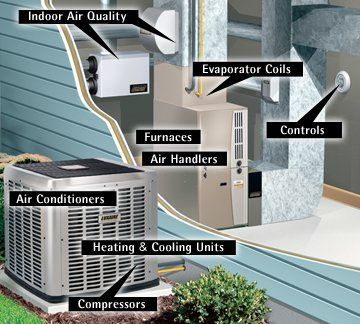
COMPONENTS OF A HOME COMFORT SYSTEM
There are two ways a system can be installed in an attic horizontal or vertical this is an example of a horizontal. Just keep in mind that the major components of a system would still be the same. Gossett would prefer to install a new system vertical so that the home owner is able to have attic space available. Sometimes this is not possible depends on the space and design of the home.
Installation of your new system is of the utmost importance when it comes to efficiency and longevity. When choosing a company to facilitate your installation be sure they have a install team that has many years of experience and continuing education with today's higher SEER rating systems they are more complex.
†IMPORTANT TO CONSIDER WHEN REPLACING†
♦EVAPORATOR COIL/CONDENSER♦
MATCHING THE INDOOR EVAPORATOR COIL WITH THE OUTSIDE CONDENSER IS IMPORTANT FOR OPTIMUM COMFORT, EFFICIENCY, AND PERFORMANCE IS CRITICAL. IMPROPERLY MATCHED EVAPORATOR COILS CAN DECREASE EFFICIENCY OF THE OUTDOOR CONDENSER AS MUCH AS 40% AND CAUSE THE INDOOR BLOWER MOTOR TO WORK HARDER THAN IT HAS TO, RESULTING IN A SHORTER LIFE AND LOWER OPERATING EFFICIENCY. WHICH MEANS HIGHER UTILITY BILLS. COMFORT IS SACRIFICED WHEN AN IMPROPERLY MATCHED SYSTEM TRIES TO KEEP UP WITH THE HEATING AND COOLING REQUESTS FROM THE THERMOSTAT. HUMIDITY PROBLEMS CAN ARISE WHEN SYSTEMS ARE NOT DESIGNED PROPERLY.
HOW AN AIR CONDITIONER WORKS
1. Indoor air is cooled as it passes over the evaporator, a set of coils (Trane designs there coils to remove as much humidity as possible) containing liquid refrigerant. The moisture in the air forms droplets on the coils and trickles outside through a drain hole.
2. Heat from the air causes some of the refrigerant to evaporate, and it passes into the compressor as a vapor.
3. The compressor increases the pressure of the refrigerant vapor, making it hotter. It loses that heat to the outside air, becoming a warm high-pressure liquid in the condenser.
4. The warm liquid refrigerant sprays through the expansion valve (located in the evaporator coil) back into the evaporator coil. As it expands, the refrigerant turns into a mixture of cold vapor and cold liquid, and the cycle is ready to begin again.
**This is an example of a horizontal system**
All Rights Reserved | Gossett Air Conditioning & Heating, Inc.
Powered By Moxy Mobile Solutions

